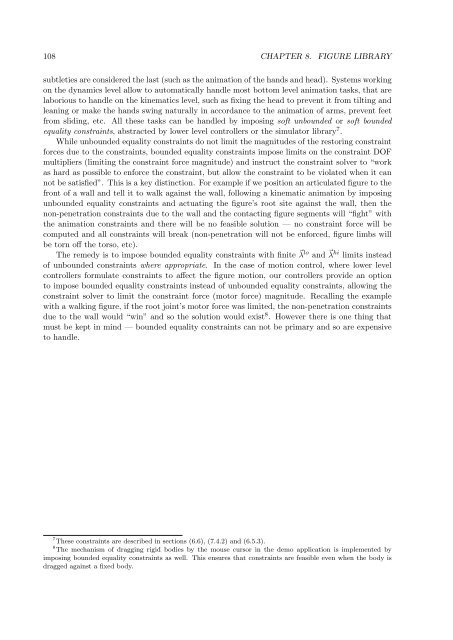thesis - Computer Graphics Group - Charles University - Univerzita ...
thesis - Computer Graphics Group - Charles University - Univerzita ...
thesis - Computer Graphics Group - Charles University - Univerzita ...
Create successful ePaper yourself
Turn your PDF publications into a flip-book with our unique Google optimized e-Paper software.
108 CHAPTER 8. FIGURE LIBRARY<br />
subtleties are considered the last (such as the animation of the hands and head). Systems working<br />
on the dynamics level allow to automatically handle most bottom level animation tasks, that are<br />
laborious to handle on the kinematics level, such as fixing the head to prevent it from tilting and<br />
leaning or make the hands swing naturally in accordance to the animation of arms, prevent feet<br />
from sliding, etc. All these tasks can be handled by imposing soft unbounded or soft bounded<br />
equality constraints, abstracted by lower level controllers or the simulator library 7 .<br />
While unbounded equality constraints do not limit the magnitudes of the restoring constraint<br />
forces due to the constraints, bounded equality constraints impose limits on the constraint DOF<br />
multipliers (limiting the constraint force magnitude) and instruct the constraint solver to “work<br />
as hard as possible to enforce the constraint, but allow the constraint to be violated when it can<br />
not be satisfied”. This is a key distinction. For example if we position an articulated figure to the<br />
front of a wall and tell it to walk against the wall, following a kinematic animation by imposing<br />
unbounded equality constraints and actuating the figure’s root site against the wall, then the<br />
non-penetration constraints due to the wall and the contacting figure segments will “fight” with<br />
the animation constraints and there will be no feasible solution — no constraint force will be<br />
computed and all constraints will break (non-penetration will not be enforced, figure limbs will<br />
be torn off the torso, etc).<br />
The remedy is to impose bounded equality constraints with finite λ lo and λ hi limits instead<br />
of unbounded constraints where appropriate. In the case of motion control, where lower level<br />
controllers formulate constraints to affect the figure motion, our controllers provide an option<br />
to impose bounded equality constraints instead of unbounded equality constraints, allowing the<br />
constraint solver to limit the constraint force (motor force) magnitude. Recalling the example<br />
with a walking figure, if the root joint’s motor force was limited, the non-penetration constraints<br />
due to the wall would “win” and so the solution would exist 8 . However there is one thing that<br />
must be kept in mind — bounded equality constraints can not be primary and so are expensive<br />
to handle.<br />
7 These constraints are described in sections (6.6), (7.4.2) and (6.5.3).<br />
8 The mechanism of dragging rigid bodies by the mouse cursor in the demo application is implemented by<br />
imposing bounded equality constraints as well. This ensures that constraints are feasible even when the body is<br />
dragged against a fixed body.
















